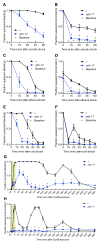Cellular stress induces a protective sleep-like state in C. elegans
- PMID: 25264259
- PMCID: PMC4254280
- DOI: 10.1016/j.cub.2014.08.040
Cellular stress induces a protective sleep-like state in C. elegans
Abstract
Sleep is recognized to be ancient in origin, with vertebrates and invertebrates experiencing behaviorally quiescent states that are regulated by conserved genetic mechanisms. Despite its conservation throughout phylogeny, the function of sleep remains debated. Hypotheses for the purpose of sleep include nervous-system-specific functions such as modulation of synaptic strength and clearance of metabolites from the brain, as well as more generalized cellular functions such as energy conservation and macromolecule biosynthesis. These models are supported by the identification of synaptic and metabolic processes that are perturbed during prolonged wakefulness. It remains to be seen whether perturbations of cellular homeostasis in turn drive sleep. Here we show that under conditions of cellular stress, including noxious heat, cold, hypertonicity, and tissue damage, the nematode Caenorhabditis elegans engages a behavioral quiescence program. The stress-induced quiescent state displays properties of sleep and is dependent on the ALA neuron, which mediates the conserved soporific effect of epidermal growth factor (EGF) ligand overexpression. We characterize heat-induced quiescence in detail and show that it is indeed dependent on components of EGF signaling, providing physiological relevance to the behavioral effects of EGF family ligands. We find that after noxious heat exposure, quiescence-defective animals show elevated expression of cellular stress reporter genes and are impaired for survival, demonstrating the benefit of stress-induced behavioral quiescence. These data provide evidence that cellular stress can induce a protective sleep-like state in C. elegans and suggest that a deeply conserved function of sleep is to mitigate disruptions of cellular homeostasis.
Copyright © 2014 Elsevier Ltd. All rights reserved.
Figures




Comment in
-
Sleep: Let sleeping worms lie.Nat Rev Neurosci. 2014 Nov;15(11):697. doi: 10.1038/nrn3849. Epub 2014 Oct 15. Nat Rev Neurosci. 2014. PMID: 25315392 No abstract available.
References
-
- Tononi G, Cirelli C. Sleep function and synaptic homeostasis. Sleep Med Rev. 2006;10:49–62. - PubMed
Publication types
MeSH terms
Substances
Grants and funding
LinkOut - more resources
Full Text Sources
Other Literature Sources
Research Materials

